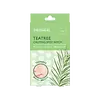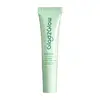Mediheal Tea Tree Calming Spot Patch Versus Glad2Glow Centella 2% Salicylic Acid Overnight Acne Spot Treatment
What's inside
What's inside
 Key Ingredients
Key Ingredients

 Benefits
Benefits

 Concerns
Concerns

 Ingredients Side-by-side
Ingredients Side-by-side

Water
Skin ConditioningButylene Glycol
HumectantSalvia Miltiorrhiza Root Extract
Skin ConditioningCentella Asiatica Extract
CleansingSpiraea Ulmaria Extract
AstringentSalicylic Acid
MaskingNiacinamide
SmoothingAmylopectin
Glycerin
HumectantXanthan Gum
EmulsifyingCyclodextrin
AbsorbentPlatonin
Skin ConditioningCeramide NP
Skin ConditioningCeramide EOP
Skin ConditioningPortulaca Oleracea Extract
Skin ConditioningPanthenol
Skin ConditioningSodium Hyaluronate
HumectantBeta-Glucan
Skin ConditioningLactobacillus/Soymilk Ferment Filtrate
Skin ConditioningPentylene Glycol
Skin ConditioningHydroxyphenyl Propamidobenzoic Acid
Skin ConditioningJuniperus Communis Fruit Extract
PerfumingMorus Alba Root Extract
BleachingPerilla Ocymoides Leaf Extract
TonicHemerocallis Fulva Flower Extract
Skin ConditioningMaltodextrin
AbsorbentCalcium Pantothenate
Urea
BufferingCaprylyl Glycol
EmollientEthylhexylglycerin
Skin ConditioningPapain
Skin ConditioningSodium Citrate
BufferingMagnesium Chloride
Magnesium Lactate
BufferingPotassium Lactate
BufferingSerine
MaskingAlanine
MaskingProline
Skin ConditioningGlycolic Acid
BufferingCaprylhydroxamic Acid
O-Cymen-5-Ol
AntimicrobialCeramide AP
Skin Conditioning1,2-Hexanediol
Skin ConditioningAcrylates/C10-30 Alkyl Acrylate Crosspolymer
Emulsion StabilisingZinc PCA
HumectantAllantoin
Skin ConditioningDipotassium Glycyrrhizate
HumectantPhytosphingosine
Skin ConditioningCholesterol
EmollientSodium Lauroyl Lactylate
EmulsifyingCarbomer
Emulsion StabilisingWater, Butylene Glycol, Salvia Miltiorrhiza Root Extract, Centella Asiatica Extract, Spiraea Ulmaria Extract, Salicylic Acid, Niacinamide, Amylopectin, Glycerin, Xanthan Gum, Cyclodextrin, Platonin, Ceramide NP, Ceramide EOP, Portulaca Oleracea Extract, Panthenol, Sodium Hyaluronate, Beta-Glucan, Lactobacillus/Soymilk Ferment Filtrate, Pentylene Glycol, Hydroxyphenyl Propamidobenzoic Acid, Juniperus Communis Fruit Extract, Morus Alba Root Extract, Perilla Ocymoides Leaf Extract, Hemerocallis Fulva Flower Extract, Maltodextrin, Calcium Pantothenate, Urea, Caprylyl Glycol, Ethylhexylglycerin, Papain, Sodium Citrate, Magnesium Chloride, Magnesium Lactate, Potassium Lactate, Serine, Alanine, Proline, Glycolic Acid, Caprylhydroxamic Acid, O-Cymen-5-Ol, Ceramide AP, 1,2-Hexanediol, Acrylates/C10-30 Alkyl Acrylate Crosspolymer, Zinc PCA, Allantoin, Dipotassium Glycyrrhizate, Phytosphingosine, Cholesterol, Sodium Lauroyl Lactylate, Carbomer
Ingredients Explained
These ingredients are found in both products.
Ingredients higher up in an ingredient list are typically present in a larger amount.
1,2-Hexanediol is a synthetic liquid and another multi-functional powerhouse.
It is a:
- Humectant, drawing moisture into the skin
- Emollient, helping to soften skin
- Solvent, dispersing and stabilizing formulas
- Preservative booster, enhancing the antimicrobial activity of other preservatives
Niacinamide is a multitasking form of vitamin B3 that strengthens the skin barrier, reduces pores and dark spots, regulates oil, and improves signs of aging.
And the best part? It's gentle and well-tolerated by most skin types, including sensitive and reactive skin.
You might have heard of "niacin flush", or the reddening of skin that causes itchiness. Niacinamide has not been found to cause this.
In very rare cases, some individuals may not be able to tolerate niacinamide at all or experience an allergic reaction to it.
If you are experiencing flaking, irritation, and dryness with this ingredient, be sure to double check all your products as this ingredient can be found in all categories of skincare.
When incorporating niacinamide into your routine, look out for concentration amounts. Typically, 5% niacinamide provides benefits such as fading dark spots. However, if you have sensitive skin, it is better to begin with a smaller concentration.
When you apply niacinamide to your skin, your body converts it into nicotinamide adenine dinucleotide (NAD). NAD is an essential coenzyme that is already found in your cells as "fuel" and powers countless biological processes.
In your skin, NAD helps repair cell damage, produce new healthy cells, support collagen production, strengthen the skin barrier, and fight environmental stressors (like UV and pollution).
Our natural NAD levels start to decline with age, leading to slower skin repair, visible aging, and a weaker skin barrier. By providing your skin niacinamide, you're recharging your skin's NAD levels. This leads to stronger, healthier, and younger looking skin.
Another name for vitamin B3 is nicotinamide. This vitamin is water-soluble and our bodies don't store it. We obtain Vitamin B3 from either food or skincare. Meat, fish, wheat, yeast, and leafy greens contain vitamin B3.
The type of niacinamide used in skincare is synthetically created.
Learn more about NiacinamideSalicylic Acid (also known as beta hydroxy acid or BHA) is a well-known ingredient for treating skin that struggles with acne and clogged pores. It exfoliates both the skin's surface and deep within the pores to help clear out buildup, control oil, and reduce inflammation.
Unlike AHAs (alpha hydroxy acids), salicylic acid is oil-soluble. This allows it to penetrate into pores which makes it especially effective for treating blackheads and preventing future breakouts.
Salicylic acid is also known for its soothing properties. It has a similar structure to aspirin and can calm inflamed or irritated skin, making it a good option for acne-prone skin that is also sensitive.
Concentrations of 0.5-2% are recognized by the U.S. FDA as an over-the-counter topical acne product.
It can cause irritation and/or dryness if one's skin already has a compromised moisture barrier, so it's best to focus on repairing that before introducing this ingredient into your routine.
While salicylic acid does not increase sun sensitivity, it’s still important to wear sunscreen daily to protect your skin.
If you are looking for the ingredient called BHA or Butylated Hydroxyanisole, click here.
Learn more about Salicylic Acid